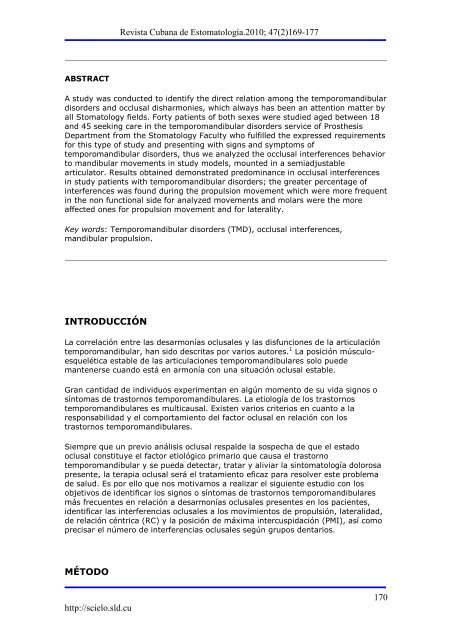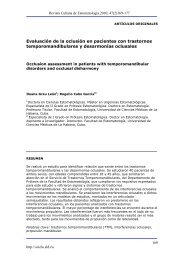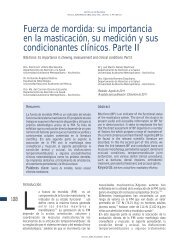o_196r9t42j11021g979cl1hignm9a.pdf
You also want an ePaper? Increase the reach of your titles
YUMPU automatically turns print PDFs into web optimized ePapers that Google loves.
Revista Cubana de Estomatología.2010; 47(2)169-177<br />
ABSTRACT<br />
A study was conducted to identify the direct relation among the temporomandibular<br />
disorders and occlusal disharmonies, which always has been an attention matter by<br />
all Stomatology fields. Forty patients of both sexes were studied aged between 18<br />
and 45 seeking care in the temporomandibular disorders service of Prosthesis<br />
Department from the Stomatology Faculty who fulfilled the expressed requirements<br />
for this type of study and presenting with signs and symptoms of<br />
temporomandibular disorders, thus we analyzed the occlusal interferences behavior<br />
to mandibular movements in study models, mounted in a semiadjustable<br />
articulator. Results obtained demonstrated predominance in occlusal interferences<br />
in study patients with temporomandibular disorders; the greater percentage of<br />
interferences was found during the propulsion movement which were more frequent<br />
in the non functional side for analyzed movements and molars were the more<br />
affected ones for propulsion movement and for laterality.<br />
Key words: Temporomandibular disorders (TMD), occlusal interferences,<br />
mandibular propulsion.<br />
INTRODUCCIÓN<br />
La correlación entre las desarmonías oclusales y las disfunciones de la articulación<br />
temporomandibular, han sido descritas por varios autores. 1 La posición músculoesquelética<br />
estable de las articulaciones temporomandibulares solo puede<br />
mantenerse cuando está en armonía con una situación oclusal estable.<br />
Gran cantidad de individuos experimentan en algún momento de su vida signos o<br />
síntomas de trastornos temporomandibulares. La etiología de los trastornos<br />
temporomandibulares es multicausal. Existen varios criterios en cuanto a la<br />
responsabilidad y el comportamiento del factor oclusal en relación con los<br />
trastornos temporomandibulares.<br />
Siempre que un previo análisis oclusal respalde la sospecha de que el estado<br />
oclusal constituye el factor etiológico primario que causa el trastorno<br />
temporomandibular y se pueda detectar, tratar y aliviar la sintomatología dolorosa<br />
presente, la terapia oclusal será el tratamiento eficaz para resolver este problema<br />
de salud. Es por ello que nos motivamos a realizar el siguiente estudio con los<br />
objetivos de identificar los signos o síntomas de trastornos temporomandibulares<br />
más frecuentes en relación a desarmonías oclusales presentes en los pacientes,<br />
identificar las interferencias oclusales a los movimientos de propulsión, lateralidad,<br />
de relación céntrica (RC) y la posición de máxima intercuspidación (PMI), así como<br />
precisar el número de interferencias oclusales según grupos dentarios.<br />
MÉTODO<br />
http://scielo.sld.cu<br />
170





